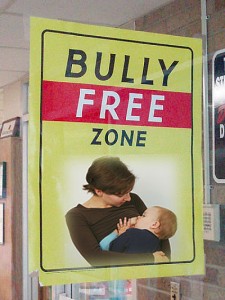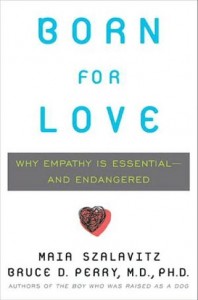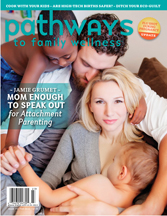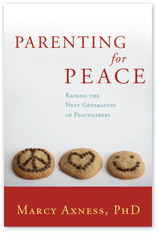 How perfect that October is Bullying Prevention Month and Attachment Parenting month — since healthy attachment is the first best anti-bullying program! Healthy attachment is the wellspring optimal brain development, especially the social brain circuitry that governs such anti-bullying capacities as self-regulation, empathy, trust, emotional and cognitive flexibility, and imagination.
How perfect that October is Bullying Prevention Month and Attachment Parenting month — since healthy attachment is the first best anti-bullying program! Healthy attachment is the wellspring optimal brain development, especially the social brain circuitry that governs such anti-bullying capacities as self-regulation, empathy, trust, emotional and cognitive flexibility, and imagination.
As I’ve written about in a prior post about the origins of empathy, my opinion (in agreement with many others) is that even the very best school-based anti-bullying or conflict resolution program puts the change lever in the wrong place — that is, way too far down a child’s developmental timeline:
If we’re serious about stopping bullying, it has to start in the home. There are ways parents can blindside bullies long before they reach the schoolyard.” This means enveloping the infant, the toddler, the preschooler (and indeed, the child at all ages, into the teen years) in the emotional warmth he needs — which includes mirroring, kindness and the security of being supported and nurtured with all of his individual needs, fears and dependence. And then as if by magic, usually imperceptibly but sometimes overnight, he will organically outgrow the childish expressions of those needs, fears and dependencies — not because he had to repress or deny them, but because he will have internalized the healthy capacities for regulating them within his own being.
And when we don’t stop bullying in the home, we must then deal with the serious neurological and psychological effects — on both the bullies and the bullied. Victims of chronic bullying can become less and less resilient to normal life stressors as their brains’ stress systems become increasingly hypersensitized to triggers. And the bullies are also at risk for anxiety, antisocial and personality disorders.
Empathy or Sociopathy?
 A remarkable example of the intersection of of impaired attachment and the bullying personality appears in Born for Love: Why Empathy is Essential, and Endangered by Bruce Perry and Maia Szalavitz. Chapter Two of their book relates the tragedy of Ryan and how his upbringing failed abysmally to provide him with the early security and relational nourishment required to develop empathy.
A remarkable example of the intersection of of impaired attachment and the bullying personality appears in Born for Love: Why Empathy is Essential, and Endangered by Bruce Perry and Maia Szalavitz. Chapter Two of their book relates the tragedy of Ryan and how his upbringing failed abysmally to provide him with the early security and relational nourishment required to develop empathy.
Out of nothing more evil than simple ignorance — together most likely with their own early lack of close nurturance, and any experience with caring for young children — a wealthy, successful couple hired a nanny to care for their son since the father worked full-time and the mother wanted to continue with her full schedule of social and philanthropic activities. That fact alone wouldn’t have necessarily posed a problem for baby Ryan’s development, since his first young nanny provided him with the soothing, closeness and responsiveness he needed for his social brain to wire up well, and for empathy to begin to flourish.
Ryan’s parents believed in quality time with their boy, and spent about an hour or so with him each day. When Ryan was eight weeks old his mother was distressed to notice that he fretted when she held him, but smiled and cooed at the nanny. The nanny was fired for being “over-involved” and a new one was hired. Ryan had eighteen nannies by the time he was three.
On his eighteenth birthday, a decorated high-school athlete already accepted to an Ivy League college, Ryan lured a developmentally disabled neighbor girl to the party at his house, gang raped her with his friends, made her “put on a show” for them, and never flinched. With sangfroid he related his story to psychiatrist Perry with indignant conviction: he didn’t “know what the problem was, really,” and “she never would have gotten laid by anyone as good as us.”
Perry discovered that Ryan’s parents simply weren’t aware that their one hour per day with him was drastically insufficient to foster the healthy, secure attachment that is the source of every kind of wellbeing for a child, and the first, best anti-bullying program. “They didn’t realize that frequently repeated routines — almost endless repetitions and specific daily rhythms — are the heart of parenting.”
And definitely the heart of attachment parenting.
Attachment Parenting in the Town Square
It would be amusing if it weren’t so mind-numbingly ridiculous that in the wake of “that Time cover,” folks got all uproarious about breastfeeding for too long — and seem to miss the glaring point that the security and connectedness fostered by a close nursing relationship and the attuned responsiveness of true attachment parenting are very likely the most effective possible anti-bullying inoculation! Indeed, society needs to realize that attachment is the first best anti-bullying program.
 That infamous Time cover of Jamie Lynne Grumet put to torturous test the old maxim “any publicity is good publicity,” since it elicited widespread scorn and ridicule toward attachment parenting. (Grumet has recently attempted to set the record straight, including appearing breastfeeding on a very different cover, AP-friendly Pathways for Family Wellness.)
That infamous Time cover of Jamie Lynne Grumet put to torturous test the old maxim “any publicity is good publicity,” since it elicited widespread scorn and ridicule toward attachment parenting. (Grumet has recently attempted to set the record straight, including appearing breastfeeding on a very different cover, AP-friendly Pathways for Family Wellness.)
One redeeming thing that came out of it was lots of lively conversation and interesting perspectives, as many of us tried to parse and unravel the fall-out — including the invariable “feminist backlash.” Alanis Morrisette gave us a great post distilling key research and practice to explain in clear, straightforward terms how attachment parenting works to accomplish this.
The Roots of Conscience
Whenever a heinous act of bullying or other violence is committed, there is talk of a lack of conscience in the perpetrator. The question of what builds a conscience has long engrossed philosophers, psychologists, and even Disney imagineers. James Prescott’s massive, cross-cultural study of the root causes of violence, together with the body of bonding and attachment research, point clearly to the fact that conscience is seeded in the nurturing, pleasurable physical and emotional connection of a baby and his mother.
It’s inescapable mammalian biology: in their poetic bestseller A General Theory of Love, the authors — three psychiatrists — explain that mammals who grow up in the absence of the coordinating influence of limbic regulation are “jagged and incomplete.” Central to this incompleteness is the missing foundation for the development of the entire suite of peacemaker capacities—including the basis of what we would call “conscience.”
 Bruce Perry simplifies the layered neuropsychological processes linking bonding, attachment and conscience to this simple calculus: People = Pleasure. When bonding and attachment unfold as nature intends, the connection between a mother and her baby remains unbroken after birth; she reliably tends to her baby’s cries and coos in an engaged, responsive way, and delights in his delight, and he comes to associate her with all that is good. Mama = Pleasure. This association lays the foundation for the child, over the course of the critical first three years, to internalize myriad more complex associations as a foundation for a healthy self (“I’m effective in the world,” “I can trust others to be there for me,” “I make people happy,” and so on), and also for his brain to eventually hardwire the broader association, People = Pleasure. It is this People = Pleasure association that underlies civilized behavior.
Bruce Perry simplifies the layered neuropsychological processes linking bonding, attachment and conscience to this simple calculus: People = Pleasure. When bonding and attachment unfold as nature intends, the connection between a mother and her baby remains unbroken after birth; she reliably tends to her baby’s cries and coos in an engaged, responsive way, and delights in his delight, and he comes to associate her with all that is good. Mama = Pleasure. This association lays the foundation for the child, over the course of the critical first three years, to internalize myriad more complex associations as a foundation for a healthy self (“I’m effective in the world,” “I can trust others to be there for me,” “I make people happy,” and so on), and also for his brain to eventually hardwire the broader association, People = Pleasure. It is this People = Pleasure association that underlies civilized behavior.
But here’s what seems to be the rub: before people can equal pleasure, there must be one person (usually the mother) whose consistent loving, sensitive care becomes associated, over the course of the first nine months or so, with the reducing of distress and the experience of pleasure. This is a critical first step and prerequisite for the child later extrapolating positive associations and empathy to others. Trying to skip this step is one big way in which we’ve thrown hefty monkey wrenches into Nature’s elegant design: we let ourselves be lulled into the industrialist notion that we could substitute and rotate humans and get an equally good result. In many ways we’ve applied a factory model to childrearing: we thought that as long as a person had the right skills, he or she was interchangeable with a baby’s mother.
And in our defense, the mechanisms by which any particular mother could be so noninterchangeable have been unfathomable to us until the recent advent of brain imaging technology, and the field of attachment neurobiology that has made such informative use of that technology.
We now know that there are dozens, maybe hundreds, of neurophysiological dimensions according to which a baby’s mother is unique and utterly irreplaceable to him — at least if we want him to flourish in growth mode and develop to his optimal potential.
Pleasure Becomes Peace
The complexity and scope of a child’s relationships are designed to sequentially expand the Mama = Pleasure association into a more intricate repertoire including ever more people, step by step. A child who is securely attached to his parents is deeply motivated to behave in harmony with them, which cultivates more pleasure all around; this becomes a positive feedback loop within the child that gradually expands outward to include the wider world in the category of “those who matter to me.”
And that is why healthy attachment is the first best anti-bullying program.
***
Images:
Bully-free zone by Eddie~S under Creative Commons license
Nursing mother by Mothering Touch under Creative Commons license
Mother and newborn by Lisa Pflaum, used with permission
Tags: attachment, attachment neurobiology, Attachment Parenting Month, brain development, Bruce Perry, Bullying Prevention Month, empathy, Jamie Lynne Grumet, pleasure, sociopathy, violence


